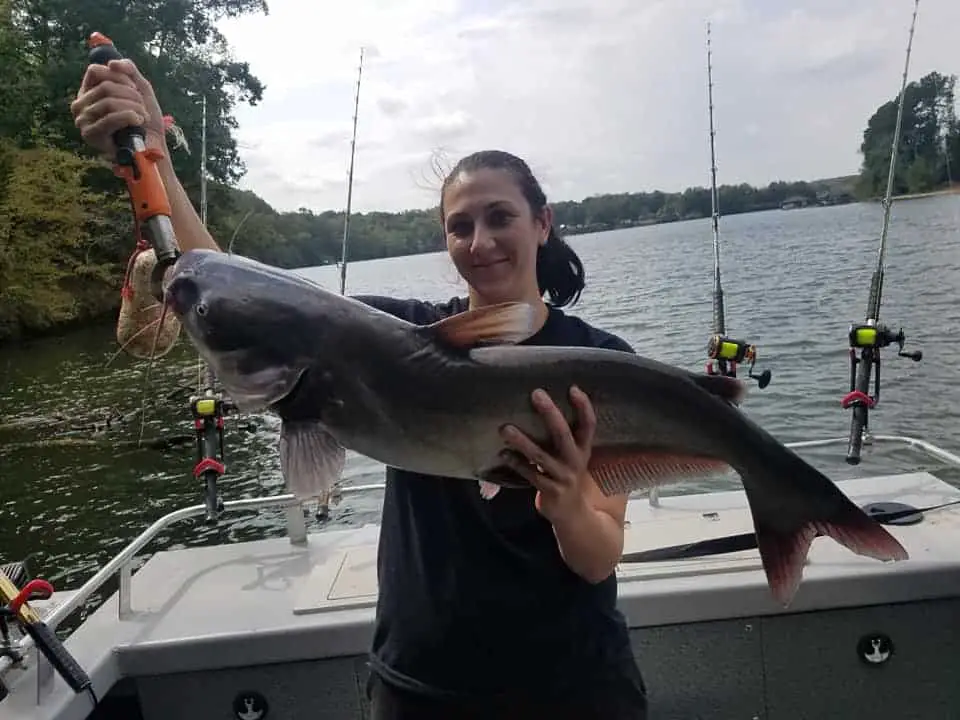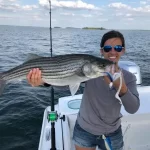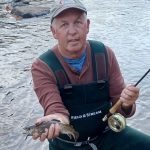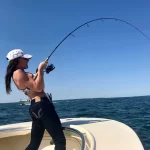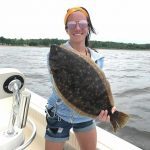Best Catfish Fishing Tackle – a Complete Guide
This article will thoroughly cover the best catfish fishing tackle and equipment. Fishing for catfish is very popular and perhaps the fastest growing aspect of freshwater fishing. There are several reasons for this. Catfish are widely distributed. Most anglers have a catfish hole pretty close to their home. Catfish are less fussy than some other species. They are also terrific eating!

The best catfish fishing tackle is a medium baitcasting rod and reel. This outfit will cover the vast majority of catfish fishing situations. Anglers that need to make longer casts may also opt for heavy spinning tackle. A selection of hooks and sinkers completes the required gear.
check out my post on the best freshwater fishing tackle and lures
For many anglers, the attraction of fishing for catfish is the chance to catch a really big fish. Both blue and flathead catfish can grow over 100 pounds. Blue catfish have been introduced into large lake and river systems to provide anglers with a trophy fishery. Obviously, heavy tackle is required for these beasts.

Catfish fishing tackle
The tackle required to go catch catfish is really not complicated. While anglers occasionally catch them on lures, the vast majority are caught on natural or prepared bait. This makes tackle selection easy for several reasons. Unlike other forms of fishing, anglers do not need to spend a bunch of money on artificial lures. Also, the rods and reels do not need to be suitable for casting these lures all day long. This simplifies things greatly.

Spinning tackle is a good choice for anglers fishing for channel catfish as well as anglers casting from shore for larger fish. The primary benefit of spinning tackle is the ability to cast a bait out a decent distance. Many anglers opt for saltwater gear as it is tough and durable, yet still affordable.
Most serious catfish anglers opt for conventional, also known as baitcasting, tackle. This is especially true for anglers that fish from a boat. There are several benefits of this type of equipment. They hold a lot of line. Conventional reels have excellent drag systems. They also provide more power since the line does not turn 90 degrees as it does with spinning gear. The downside is the limited casting ability.

Best catfish fishing tackle for different catfish species
The catfish tackle that an angler needs will depend on the type and size of catfish that is being sought. Unlike other forms of fishing, catfish vary greatly in size, from 2 pound “eaters” to one hundred pound monsters. Obviously, the tackle requirements will need to match the application.
The three primary catfish species found in North America are the channel catfish, blue catfish, and flathead (also know as yellow cat) catfish. There are many species of bullhead and smaller catfish species. However, since for the most part they are small, the focus will be on the main three species.

Channel catfish
Channel catfish are the most widely distributed catfish species in North America. They are found in most freshwater creeks, ponds, lakes, and rivers, as long as the water does not get too cold. Channel catfish are opportunistic feeders. The list of things they won’t eat is much shorter than what they will eat. Channel catfish do like a bit more current than the other species and are caught in flowing rivers.

The world record channel catfish is 58 pounds. However, fish over 20 pounds are not at all common. Most will run between two and ten pounds. In fact, most anglers looking for a few fish to eat prefer fish in the two to five pound range. Top channel catfish baits include nightcrawlers, chicken livers, crayfish, cut bait, and prepared baits. However, they are caught on many more baits that that.
Best tackle for channel catfish fishing
Since channel catfish are of moderate size, medium spinning tackle is well suited to catching catfish. Most anglers already own a suitable outfit. Spinning tackle allows anglers fishing from shore to make longer casts out into the lake or river. A 7 foot medium action rod with a 3000 series reel will work fine. It can be spooled with 12 pound monofilament or 20 pound braided line. Here is a Penn Battle 5000 combo for $160, nice versatile outfit.
Light conventional tackle is perfect for anglers fishing from a boat and targeting larger catfish. With a little practice, anglers can learn to cast these rigs effectively. They are quite versatile and affordable. A 7 ½ foot medium to medium heavy outfit spooled up with 20 pound braid is a good all round set up. Here is a nice specifically designed catfish outfit from Abu Garcia for $100.
“Fishing Lido Key is a participant in the Amazon Associates Program, an affiliate advertising program designed to provide a means for sites to earn advertising fees by advertising and linking to Amazon. As an Amazon Associate I earn from qualifying purchases.”
Blue catfish
Blue catfish grow very large! The record blue cat is a 130 pound monster. Blue catfish are mostly found in larger bodies of water. They have been successfully introduced into many large lake and river systems to provide anglers with a trophy fishery.

Blue catfish feed primarily on larger bait fish such as shad and herring. That is one of the reasons they do so well in larger lakes and reservoirs. The best bait is usually fresh cut shad and herring that is found in the body of water being fished.
Best blue catfish fishing tackle
Anglers targeting blue catfish will require stout gear. While heavy spinning gear can be used, medium heavy to heavy conventional tackle is a better choice. Catching a trophy blue catfish will require a heavy outfit spooled up with 60 pound braided line.
Flathead catfish

Flathead catfish, or “yellow cats” prefer slow moving rivers. These are perhaps the most difficult of the three species to catch. They are less widely distributed and are also loners, they rarely school up. Flathead catfish feed primarily on live bait fish and do not scavenge as the other species do. Where legal, live sunfish are a prime bait.
Best flathead catfish fishing tackle
The world record flathead catfish is 123 pounds. The average fish is quite large. Also, since large, live baits are often used, stout tackle is needed. Flathead catfish are also usually found near fallen trees and other structures. Heavy conventional tackle spooled up with 60-80 pound braided line works best.
Line choices for catfish fishing
In most cases, braided line is the best choice for anglers fishing for catfish. The combination of big fish and heavy cover dictates this choice. 40-60 pound braid works well in most applications. However, anglers targeting pan sized channel catfish can certainly do fine using 12-15 pound monofilament line.
Catfish fishing hooks
Anglers seeking the best catfish fishing tackle have a lot of choices when it comes to hooks. Where legal, many anglers choose treble hooks, especially for channel catfish. #6 is a good all round size. Special hooks are designed with a coil to hold prepared dough baits and similar baits on the hook.
Most anglers fishing with cut bait opt for circle hooks. They rotate in the fish’s mouth and usually hook them in the corner of the mouth. This also reduces fish mortality and facilitates an easier release. It is important to just come tight and NOT set the hook when using circle hooks.
Larger circle hooks are required for these hooks to work properly, especially when using larger baits. 8/0 to 10/0 circle hooks are often used. This seems large, but the gap is what is important.
Anglers need strong hooks when fishing for catfish. Hook strength is listed as “x”. For example, a 4x hook is stronger than a 2x hook. Anglers fishing for catfish should choose 4x or 6x hooks. Stout, short shank bait hooks are still used successfully by many anglers.
Catfish sinkers

Sinkers, or weights, are simply heavy weights which both allow for the bait to be cast and to get and keep the bait on the bottom where catfish feed. The basic rule of thumb is to use the least amount of weight required to accomplish this. Heavy currents and deeper water will require the use of more weight.
No roll sinkers are very effective and are quite popular among catfish anglers. They lie flat on the bottom and hold their position well. The sinker has a hole in it, the line slides through it. A swivel then stops the sinker. A short leader and hook finishes off the rig. Bank sinkers are used when drifting and also to keep a bait a little bit off the bottom. One ounce to three ounce sinkers will cover most situations.
Other catfish fishing gear
There are a few other items of equipment that catfish anglers should consider. These include a pair of pliers, fish lip gripper, landing net, scissors, scale, and a fillet knife. Most anglers already own tackle boxes, though a dedicated box for catfish can be put together.
Pliers
A good pair of pliers are an essential device for every angler. They cut line, pull knots tight, and safely remove hooks from the mouth of a fish. Some have holsters and many sport a lanyard to keep them from falling in the water.
Fish gripper
A lip gripper can really make handling a decent sized catfish much easier! Anglers can control a fish, remove the hook, and hold it up for a picture much easier. Here is a kit with both pliers and a gripper for $24.
Landing net
Anglers fishing for catfish will find a big landing net to be an important part of the best catfish fishing tackle and gear. These will help land larger catfish instead of lifting or wrestling them over the gunnel or bank.
Scissors
Scissors are very helpful when fishing for catfish in a couple of instances. Braided line is often easier to cut with scissors than with pliers. Also, they make cutting bait into chunks or strips easier and safer as well. Some anglers have both small scissors and game shears.
Scale
Some anglers like to know exactly how heavy their catfish is. For this, they require a portable scale. This is more of a luxury item as opposed to a required piece of equipment.
Fillet knife
Anglers desiring to keep a fish or two for dinner will need a knife to clean it. Many prefer electric knives, though manual blades work fine as well. The knife needs to be large and stout for cleaning a decent sized catfish.
Catfish fishing tips and techniques
Catfish can be caught in a wide variety of environments. They are landed by anglers fishing in the smallest of creeks as well as the largest lakes in the country. Slow-moving, mid-sized rivers are prime habitat. Tailwaters are fantastic spots to target catfish as well.
River fishing for catfish
Rivers are great waters to target catfish. Anglers fishing in rivers have an advantage over those fishing and lakes; there is simply much less water in which to search for fish. Small rivers in particular are excellent spots to target catfish, especially for novice anglers.

Outside bends in rivers are the top spots in most cases. The current flow gouges out and undercut bank as well is a deep hole on the outside bends of river channels. This results in these areas often times being the deepest portions of the river. Additionally, current deposits debris such as fallen trees and other cover which then accumulates in these holes. This is perfect catfish habitat.
Anglers can have great success by simply moving from one outside corner or bend to the next. Generally speaking, the straight portions of rivers tend to be less attractive to fish. There is nothing of interest to hold them, unless there is a significant depth change or other feature that will attract fish.
Larger rivers are a completely different situation. These rivers can be dangerous and angler should always put safety first! Strong currents and eddies along with unseen hazards can create a very dangerous situation. Commercial barge traffic is often present. However, some of the largest catfish in the world are caught in large rivers.

Outside bends are less of an issue in large rivers as they are in small rivers. Catfish will relate more to underwater bars, sunken debris and other structure, holes, ledges, points, bridges, and anything else that will break up the current and give them a good ambush location.
River conditions affect catfish
Conditions are an important factor when river fishing for catfish and other species. Water height and flow will have an impact on fish movements as well as being a safety consideration. During periods of high water, which is often times in the spring, fish will move out of the main river channels to escape the strong current. Sloughs and backwater areas off of the main channel will be better spots to fish. This can also be a dangerous time to be out an angler should be extra careful!

Conversely, during periods of low water catfish will congregate in the deeper areas of rivers. There simply will not be enough water on the shallow bars and flats to hold them. This often occurs in summer when the water is warm. The deeper holes will be cooler, which is another factor that will attract and hold fish.
Bait presentation is important in rivers, whether anglers or fishing from a boat or from shore. In most cases, the best technique is to approach the structure or area to be fished from the up current side. The bait is then presented downstream to the fish, with the bait being placed just ahead of the structure. This will result in the current taking the scent of the bait downstream to the fish and hopefully pulling it out away from the structure. Presenting the bait right in the structure will often result in a snag.
How to catch catfish in lakes

Lakes throughout North America offer anglers excellent opportunities to catch all three major species of catfish. Targeting catfish and large lakes can be overwhelming as there is so much area to be covered. However, lakes often produce the largest catfish. The primary reason for this is simple, forage.
Many lakes, particularly Southern impoundments, are full of shad and herring that were stocked as forage for striped bass. This has resulted in an outstanding environment for catfish to thrive in.

Catfish are similar to other game fish in that they have the same basic needs. They prefer some type of structure that they can relate to. Cover and structure offer fish a feeling of safety along with a spot from which to ambush prey. While catfish are fairly tolerant to a wide range of water temperature, water that is either very warm or very cold will affect their movements and behavior.
The same types of spots that produce striped bass, largemouth bass, and other game fish species will hold catfish as well. These include bends in the sunken river channel, long sloping points, bluff banks, flats, bridges, docks, artificial reefs or fish attractors, the mouths of creeks are rivers entering the lakes, and deeper holes.
Catfish migrations in lakes
Catfish do have a seasonal migration in most lakes. As it warms up in the spring, they move up into the rivers, creeks, and tributaries in order to spawn. Areas with gravel or rocky bottom are prime spots. Once the spawning process is completed, catfish will scatter out into the main lake areas. During summer, catfish will often be found in the deepest portions of the lake, particularly near the dam. This area of the lake is often the deepest, coolest, and will attract the most bait.

As it cools off in the fall, catfish will once again move shallow as the water temperatures drop. Large flats in 10 feet of water to 15 feet of water adjacent to deep channel edges are great spots to try. Tributary mouths along with sloping points are also high percentage catfish spots in the fall. Striped bass often times will be seen schooling on the surface this time of year. Catfish can often times be found under the schools of feeding fish, gorging on the easy scraps.
Anglers targeting catfish in lakes have one advantage over river anglers; they can put out multiple lines behind the boat and off to the sides in search of fish. Often times, anglers fishing and rivers can only put out a couple of lines due to the current. However, this is not to case and lakes. Depending on local laws, anglers can put out quite a spread and cover a large area of water from a single location. This will help the catfish angler dial in the depth, presentation, and bait that is most effective on that outing.
How to catch catfish in tailwaters
Tailwaters are fantastic spots to fish for catfish as well as just about every other freshwater species. Fish just naturally are attracted to current, and catfish are no exception. Flowing water gives game fish an advantage over bait fish. The water flowing through and/or over a dam can be quite swift. Catfish are well adapted to maneuver in this environment and they will feed heavily on the available forage.
Often times, bait fish such as shad, herring, bluegill, and other species can get chopped up going through the turbines of a hydroelectric dam. This provides an easy meal for catfish and other species as they lie in the current at the base of the dam and wait for the buffet to begin.
Boating in tailwaters can be dangerous! Anglers should always heed warnings and never anchor the boat from the stern. In many cases, these areas are accessible from shore. This is an excellent opportunity for anglers without a boat to have the chance to catch a big fish. Any lake or river system that has a decent population of catfish should have excellent fishing in the tail water area below the dam.
In conclusion, this article on the best catfish fishing tackle and gear will help anglers all over North America have more success!
